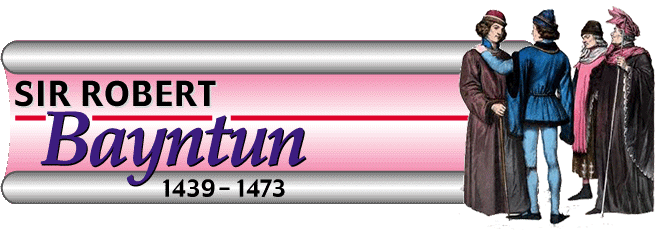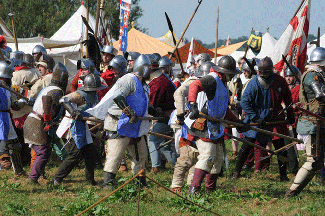
|
Timeline
1449: England lost the “Battle of Brittany”. 1450: England lost the Battle of Normandy. 1453: England lost the Battle of Gascony which led to the conclusion of the 100 Years’ War. Also at this time Henry became ill, suffered from a breakdown, and was unable to perform his regular duties for over a year. 1454: Richard of York was appointed Protector of England in February as Henry VI declared temporarily insane. Parliament gave him the right to rule on the king's behalf. 1455: Henry recovered briefly from his illness and led his forces into battle with Richard at the Battle of St. Albans on 22nd May. This was the beginning of the Wars of the Roses (1455-1485) – the English Civil War between the Houses of York (White Rose) and Lancaster (Red Rose). King Henry VI came from the Lancaster family but was defeated by Richard, captured and imprisoned in the Tower of London. Also at this time the handgun replaced the steel bow and more castles were built as means of fortification after the introduction of gunpowder. |
Robert Bayntun was born in 1439, at Faulston House, in the County of Wiltshire. At the inquest of this father in 1465 his age was recorded as 26. He was known as Robert Baynton, however we see the spelling of the surname changing to Bayntun from the beginning of the 17th century. He married Elizabeth Haute some time around 1459, the daughter of William Haute, of Waddenhall, Kent, Knight of the Shire for Kent, and his wife Joan Wydeville, who was the daughter of Richard Wydeville of Grafton, Northamptonshire. Elizabeth was a first cousin of Queen Elizabeth Wydeville, the wife of King Edward IV of England. The Bayntun family had long been supporters of the House of Lancaster and as a partisan, in the Wars of the Roses, Sir Robert fought for King Henry VI against the forces of King Edward IV at the Battle of Tewkesbury on May 4, 1471. He was one of many heraldic knights on the battlefield, including fellow Lancastrians: Sir John Arundell; Edmund Beaufort, the Duke of Somerset; John Courtney, the Earl of Devonshire and Edward of Lancaster, the Prince of Wales. Some famous Yorkists also included were: Sir Richard de Beauchamp; John Butler, the Earl of Ormond; John Mowbray, the Duke of Norfolk and Richard Plantagenet, the Duke of Gloucester – later King Richard III. However, King Henry was defeated and Sir Robert Bayntun was immediately declared a traitor, thereby losing all his property and the Manor of Faulston, the Manor of Horton, the Manor of Chilton Candover, the Manor of Tollard Lucy and the Manor of Lower Wroughton were among those forfeited to the Crown. The Manor of Weeke (or Wyke) contained the several divisions of Upper, Middle and Lower Week. A chapel was formerly appropriated to Upper Week in St. Mary Bourne church, afterwards referred to as the “week aisle”. This manor was held by Robert's great-grandfather, Nicholas Bayntun in 1422 and in 1466 it was held by his father, John Bayntun. It was later held by Robert Bayntun, but like the others, this manor was also seized by the Crown. Sir Robert was among an elite group who were taken prisoner after the Battle of Tewkesbury, whose lives were also spared by King Edward. These included: Queen Margaret of Anjou, the wife of Henry VI of England, who had led the Lancastrian forces; Anne Neville, the wife of the slain Prince Edward of Westminster, the Prince of Wales; Dr. Ralph Makerell, Parson of Risby, companion of Queen Margaret and Dr. John Morton of Bere Regis, afterwards Bishop of Ely, Archbishop of Canterbury and Cardinal. As for the victor's, most were knighted after the battle. Although spared, Sir Robert Bayntun is said to have died on the 6th October 1475 but the cause of his death is not known. He is referred to in the Plea Roll (see below) as Robert Baynton (late of Faulston), which proves he was definitely dead by 1479. An extract from a Plea Roll – Edward IV outlines the reason for Robert Bayntun’s capture and conviction, dated Michaelmas 19 Edward IV (1479). Robert Baynton late of Faulston in the County of Wiltshire, knight, Thomas Tresham, late of Sywell in the county of Northampton, knight and John Delves, late of Uttokeshater, in the county of Stafford, with a great number of rebels and traitors, had assembled on the 4th day of May, the eleventh year of the reign of Our Sovereign Lord Edward IV (1471), at Tewkesbury, Gloucestershire, and had there feloniously and traitorously levied war against King Edward IV, their natural liege lord, and royal person, he being there in person with his banner displayed, intending traitorously then and there the final destruction of the said most royal person, it had been declared, ordained, and adjudged by the said kings highness, with the advise of the lords spiritual and temporal and commons in this present parliament assembled and by the authority of the same, that the said Robert Baynton, Thomas Tresham and John Delves for their great and heinous treasons and offences as specified by them, committed and done, were convicted and attained of high treason, and by the same authority that the said Robert Baynton, Thomas Tresham and John Delves should forfeit to the said liege lord, the king and his heirs, all castles, manors, demesnes, vills, honours, lands, tenements, rents, services, fee farms, knights’ fees, advowsons, reversions and hereditaments, which the said Robert Baynton, Thomas Tresham and John Delves, or any of them had of estate of inheritance, or any other to their use, on the said 4th May or at any other time afterwards up to the date of the said Act in England, Ireland, Wales, or Calais, or the Marches. Before his death in 1465, Robert's father, Sir John Bayntun, made a gift, for the term of one life to his son Robert and his wife Elizabeth, the Manor of Marsh Baldon with appurtenances in Marsh Baldon and Newnham, in the County of Oxfordshire; the Manor of Compton Bassett, with appurtenances in Compton Bassett, Tilshead, Wilton and Barford St. Martin. Also a meadow called 'Kingesham', with appurtenances in Compton Chamberlayne, and lands and tenements in East Winterslow. From the time Sir Robert was attained in 1471, his home, Faulston House and manor, ceased to be the residence of the Bayntun family. The crown held this, and all of the Bayntun lands, but his wife, Elizabeth, was allowed the profits of the Manor or Baldon, until her husband's death in 1475. Then in that year, they were granted in tail-male to Sir John Cheyne, one of the King's Esquires of the Body. Elizabeth complained of her supersession, claiming that Robert's father had granted the manors of Marsh Baldon and Compton Bassett, and a lot of other lands, to her husband and herself in fee. A Commission was appointed in May 1476 to enquire into her complaint, but the outcome of this enquiry is not documented. There is no further mention of Elizabeth from this date and it is not known where she and her children lived during this period of time. Perhaps she may have been granted one of the tenements attached to some of the above manors. In 1483, the above mentioned John Cheyne was himself attained, following the rebellion against Richard III and the Manor of Faulston, the Manor of Horton, the Manor of Marsh Baldon and the Manor of Chilton Candover were granted to George Neville for his services against the rebels. But after the Battle of Bosworth in 1485, these manors were again restored to Cheyne, and following his death in 1487, they were passed onto one of his heirs. In 1496 Sir Robert's brother, William Bayntun, then living in Alton, Westbroke, Hampshire purchased a property in the Market Place at Alton from Edward Brocas, chaplain, the son and heir of Sir Thomas Brocas. The corner property was situated in the Borough of Alton, commonly called Ladyplace, together with it's adjacent gate, two gardens, grange and stable. When Sir Robert Bayntun died he was succeeded by his eldest son and heir John Bayntun |



